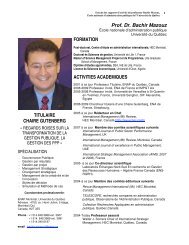Why do firms both make and buy? An investigation of concurrent ...
Why do firms both make and buy? An investigation of concurrent ...
Why do firms both make and buy? An investigation of concurrent ...
You also want an ePaper? Increase the reach of your titles
YUMPU automatically turns print PDFs into web optimized ePapers that Google loves.
304 A. Parmigiani<br />
by the y-axis. The figure indicates that <strong>concurrent</strong><br />
sourcing is sometimes the middle choice, such as<br />
with firm expertise, while other times it is not,<br />
such as with technological uncertainty. It appears<br />
that some variables may indeed act continuously,<br />
with <strong>concurrent</strong> sourcing associated with an intermediate<br />
level <strong>of</strong> the attribute, while others <strong>do</strong> not.<br />
Concurrent sourcing appears to be a distinct<br />
choice over making or <strong>buy</strong>ing, rather than a linear<br />
combination <strong>of</strong> the two sourcing modes. Perhaps<br />
<strong>concurrent</strong> sourcing is chosen first, with the secondary<br />
decision being the extent <strong>of</strong> internal production.<br />
As an exploratory exercise, models were<br />
created to relate the percentage <strong>of</strong> internal production<br />
for only the <strong>concurrent</strong>ly sourced goods<br />
with the variables used in the other models. These<br />
models are not displayed owing to relatively poor<br />
explanatory power (pseu<strong>do</strong> R 2 = 0.093), but some<br />
interesting results did occur. Asset specificity did<br />
not affect the percentage made. While performance<br />
uncertainty was positively <strong>and</strong> directly related<br />
to internalization, the other uncertainty variables<br />
were not significant. Firm scope economies were<br />
related to the percentage produced internally, while<br />
the scope interaction was not. Firm <strong>and</strong> supplier<br />
expertise affected this percentage, but the interaction<br />
did not. These findings suggest that the<br />
percentage produced internally could be affected<br />
by different variables from those that influence the<br />
initial decision to source internally, externally, or<br />
<strong>concurrent</strong>ly.<br />
Several control variables also deserve mentioning.<br />
Unionized <strong>firms</strong> were more likely to <strong>concurrent</strong>ly<br />
source; it may be difficult for them to<br />
completely outsource due to contractual commitments<br />
or they desire outside suppliers as a benchmark.<br />
Higher-volume goods were less likely to be<br />
<strong>concurrent</strong>ly sourced <strong>and</strong> more likely to be outsourced,<br />
following economies <strong>of</strong> scale logic. More<br />
homogeneous goods were also more likely to be<br />
<strong>concurrent</strong>ly sourced, perhaps because this facilitates<br />
the comparison between internal <strong>and</strong> external<br />
<strong>of</strong>ferings. This contradicts the TCE assumption <strong>of</strong><br />
heterogeneity among <strong>concurrent</strong>ly sourced goods<br />
(i.e., more customized goods produced internally<br />
<strong>and</strong> more generic ones outsourced).<br />
In summary, all three theories assisted in explaining<br />
the sourcing choice. TCE logic was supported<br />
as <strong>firms</strong> were less likely to <strong>buy</strong> when<br />
markets were thin <strong>and</strong> more likely to <strong>make</strong> if<br />
performance uncertainty was great. The neoclassical<br />
economics prediction <strong>of</strong> greater firm <strong>and</strong><br />
supplier scope economies leading to <strong>concurrent</strong><br />
sourcing was confirmed. The capabilities view was<br />
supported as greater combined firm <strong>and</strong> supplier<br />
expertise led to <strong>concurrent</strong> sourcing, as did greater<br />
technological uncertainty that may motivate <strong>firms</strong><br />
to search for knowledge <strong>both</strong> internally <strong>and</strong> externally.<br />
Moreover, support was shown for a discrete<br />
choice between making, <strong>buy</strong>ing, <strong>and</strong> <strong>concurrent</strong><br />
sourcing over a continuum view. This suggests that<br />
<strong>firms</strong> that <strong>concurrent</strong>ly source may only need to<br />
<strong>buy</strong> or <strong>make</strong> a minor percentage <strong>of</strong> their requirements<br />
<strong>and</strong> still get the governance benefits <strong>of</strong> <strong>both</strong><br />
market <strong>and</strong> hierarchy.<br />
CONCLUSION AND IMPLICATIONS<br />
This study assists in clarifying the confusion surrounding<br />
firm boundaries <strong>and</strong> hybrid governance<br />
modes through investigating why <strong>firms</strong> would <strong>concurrent</strong>ly<br />
source, simultaneously making <strong>and</strong> <strong>buy</strong>ing.<br />
By incorporating transaction cost, neoclassical<br />
economics, <strong>and</strong> capabilities theories, a holistic<br />
view <strong>of</strong> why <strong>firms</strong> would use this sourcing mode is<br />
presented, revealing aspects <strong>of</strong> each theory motivating<br />
the sourcing choice. Finding that all three<br />
theories contribute to the choice <strong>of</strong> sourcing mode<br />
illustrates the firm’s desire to simultaneously monitor<br />
suppliers, produce efficiently, <strong>and</strong> improve processes.<br />
In addition to underst<strong>and</strong>ing why <strong>firms</strong> <strong>concurrent</strong>ly<br />
source, this study addressed the question <strong>of</strong><br />
whether <strong>concurrent</strong> sourcing was a midpoint along<br />
the <strong>make</strong>/<strong>buy</strong> continuum or whether it was a discrete<br />
<strong>and</strong> distinct choice. The superiority <strong>of</strong> the<br />
multinomial over the ordered logit models <strong>and</strong> the<br />
findings summarized in Figure 1 support the discrete<br />
choice perspective. This suggests that <strong>firms</strong><br />
benefit from the <strong>concurrent</strong> use <strong>of</strong> the two governance<br />
modes <strong>of</strong> market <strong>and</strong> hierarchy, not the<br />
extent <strong>of</strong> one or the other. This supports <strong>concurrent</strong><br />
sourcing as a plural governance mode (Bradach<br />
<strong>and</strong> Eccles, 1989).<br />
By separating plural modes from other types<br />
<strong>of</strong> governance modes, we can better underst<strong>and</strong><br />
hybrid modes. Some modes <strong>do</strong> use two mechanisms<br />
simultaneously <strong>and</strong> thus are considered plural,<br />
such as dual distribution channels in which<br />
<strong>firms</strong> simultaneously use inside salespeople <strong>and</strong><br />
outside representatives, <strong>and</strong> franchising in which<br />
a franchisor simultaneously operates some units<br />
<strong>and</strong> enlists franchisees to run others. Other modes,<br />
Copyright © 2007 John Wiley & Sons, Ltd. Strat. Mgmt. J., 28: 285–311 (2007)<br />
DOI: 10.1002/smj





